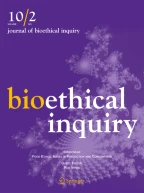932Accesses
5Altmetric
Abstract
The disciplines of ethics, science, and the law often conflict when it comes to determining the limits and boundaries of embryo research. Under current Australian law and regulations, and in various other jurisdictions, research conducted on the embryo in vitro is permitted up until day fourteen, after which, the embryo must be destroyed. Reproductive technology and associated research is rapidly advancing at a rate that contests current societal and ethical limits surrounding the treatment of the embryo. This has brought about the question of the adequacy of the fourteen-day rule and whether it is necessary for it be reconsidered and reformed. This paper will highlight some of the tensions that exist in ethics, science, and the law in relation to the extension of the rule. It will be concluded that any move to extend the rule must be accompanied by close consultation with the public as the ultimate stakeholders in how the future of reproductive technology is created, constructed, and contested.
This is a preview of subscription content,log in via an institution to check access.
Access this article
Subscribe and save
- Get 10 units per month
- Download Article/Chapter or eBook
- 1 Unit = 1 Article or 1 Chapter
- Cancel anytime
Buy Now
Price includes VAT (Japan)
Instant access to the full article PDF.
Similar content being viewed by others
Notes
See for example,Crimes Act 1900 (NSW) s 20 andR v Hutty [1953] VLR 338, 339.
Crimes Act 1900 (NSW) ss 4 and 42;Crimes Act 1900 (ACT) ss 43 and 48A;Criminal Code 1899 (Qld) s 313(1);Crimes Act 1958 (Vic) s 15;Criminal Code 1924 (Tas) s 184A.
Watt v Rama [1972] V.R. 353.
References
Buxon, J. 2017. Comment: What’s so special about the status of the embryo?BioNews 886: January, 30.
Cavaliere, G. 2017. A 14-day limit for bioethics: the debate over human embryo research.BMC Medical Ethics 18(1): 1–12.
De Lacey, S. 2017. Death in the clinic: Women’s perceptions and experiences of discarding supernumerary IVF embryos.Sociology of Health and Illness 39(3): 397–411.
De Lacey, S., W. Rogers, A. Braunack-Mayer, J. Avery, D. Smith, and B. Richards. 2012. Perceptions of embryo status and embryo use in an Australian community.Reproductive BioMedicine Online 24(7): 727–744.
Deglincerti, A., G.F. Croft, L.N. Pietila, M. Zernicka-Goetz, E.D. Siggia, and A.H. Brivanlou. 2016. Self-organization of the in vitro attached human embryo.Nature 533(7602): 251.
Department of Health and Social Security. 1984.Report of the Committee of Inquiry into Human Fertilisation and Embryology. London: Her Majesty’s Stationary Office.
Haimes, E., and K. Taylor. 2009. Fresh embryo donation for human embryonic stem cell (hESC) research: The experiences and values of IVF couples asked to be embryo donors.Human Reproduction 24(9): 2142–2150.
Herbrand, C. 2016. Comment: The Warnock Report and the 14-day rule.BioNews 882: December 19.
Hyun, I., A. Wilkerson, and J. Johnson. 2016. Revisit the 14-day rule.Nature 533(7602): 169–171
International Society for Stem Cell Research. 2016. Guidelines for stem cell research and clinical translation.http://www.isscr.org/docs/default-source/all-isscr-guidelines/guidelines-2016/isscr-guidelines-for-stem-cell-research-and-clinical-translation.pdf?sfvrsn=4. Accessed December 10, 2018.
IVF Australia. 2011.Female infertility and assisted reproduction. Merck Serono Australia Pty Ltd.
Jones, D. 2016. The injustice of destroying embryonic human beings. Paper presented at the annual conference of the Progress Educational Trust,Rethinking the ethics of embryo research: Genome editing, 14 days and beyond, London, December 7.
Legislation Review Committee. 2005.Legislation review: Prohibition of Human Cloning Act 2002 and Research Involving Human Embryos Act 2002. Parliament of Australia.
Millbank, J. 2013. Frozen in time, clarifying laws on IVF and embryo destruction.The Conversation, January 21.
National Health and Medical Research Council. 2017.Ethical guidelines on the use of assisted reproductive technology in clinical practice and research. Canberra: Commonwealth of Australia, ISBN 9781925129809.
———. 2015.National statement on ethical conduct in human research. Canberra: Commonwealth of Australia.
Noventa, M., A. Andrisani, S. Gizzo, G.B. Nardelli, and G. Ambrosini. 2014. Is it time to shift the attention on early stages embryo development to avoid inconclusive evidence on HPV-related infertility: Debate and proposal.Reproductive Biology and Endocrinology 12(1): 48.
Shahbazi, M.N., A. Jedrusik, S. Vuoristo, et al. 2016. Self-organization of the human embryo in the absence of maternal tissues.Nature: Cell Biology 18: 700–708.
Shaikly, V. 2016. Comment: The 14-day rule: calling time on embryo research.BioNews, December 7.
Walsh, A. 2015.The legal status of prenatal life in Australia. Postgraduate Thesis, University of Sydney, Australia.
Warnock, M. 1984. Scientific research must have a moral basis.New Scientist 104(1430): 36.
Author information
Authors and Affiliations
Australian National University, Canberra, Australia
Caitlin Davis
- Caitlin Davis
You can also search for this author inPubMed Google Scholar
Corresponding author
Correspondence toCaitlin Davis.
Rights and permissions
About this article
Cite this article
Davis, C. The Boundaries of Embryo Research: Extending the Fourteen-Day Rule.Bioethical Inquiry16, 133–140 (2019). https://doi.org/10.1007/s11673-018-09895-w
Received:
Accepted:
Published:
Issue Date:

